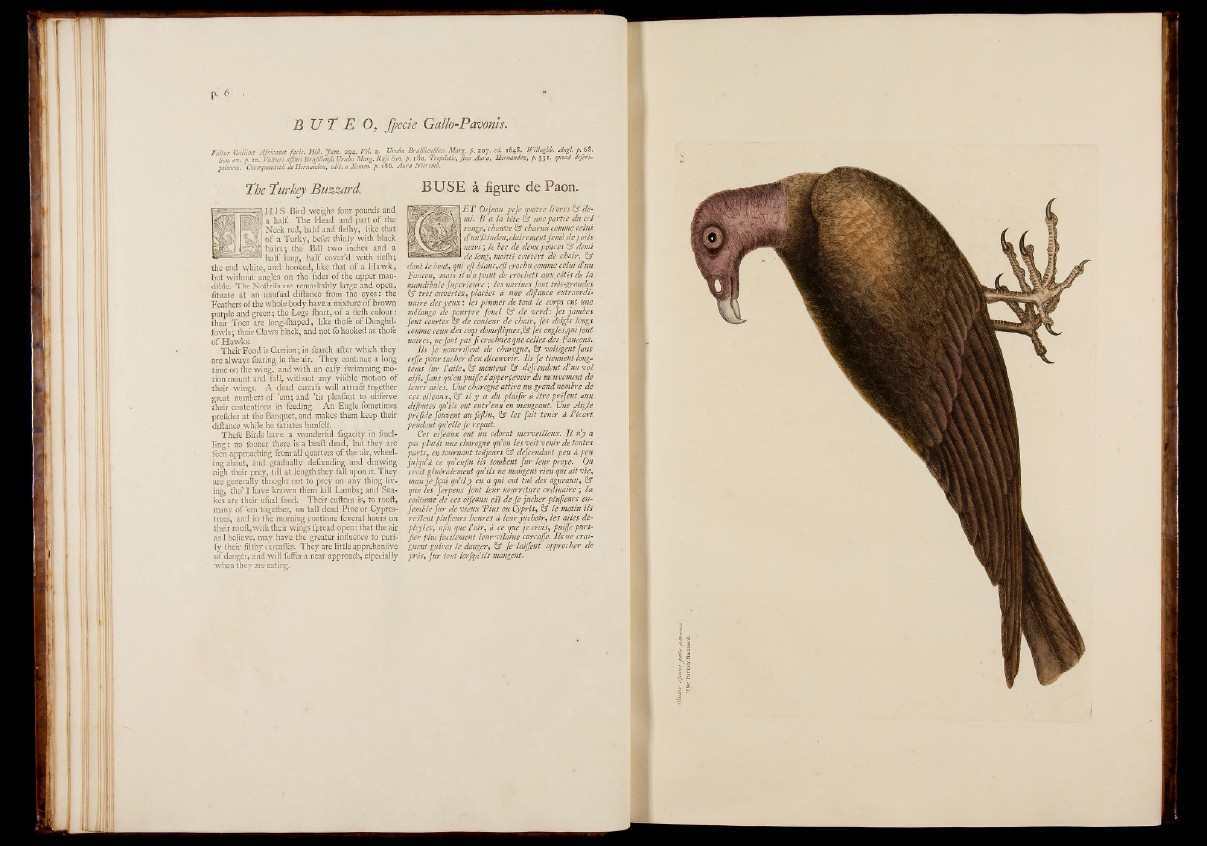
p . 6
B U T E O, fpecie Gallo-Pavoms.
The Turkey Buzzard.
H I S Bird weighs fpur pounds and
a half. The Head and part of the
Neck red, bald and flefhy, like that
of a Turky, befet thinly with black
'hairs; the Bill two inches and a
half long, half covered with tieih;
the end white, and hooked, like that of a Hawk,
but without angles on the Tides of the upper mandible.
The Noftrils are remarkably large and open,-
fitiiate at an uriufiial diftance from the eyes : the
Feathers of the whole body have a mixture of brown
purple and-green; the Legs ihort, of a flefh colour:
their Tees, are long-fhaped, like thofe'of Dunghil-
fowls; their Claws black, and not ib hooked as thofe'
of Hawks.
Their Food is Carrion; jn fearch after which they.
are always ioaring. in the air. They continue a long
time' on the wing, and with an eafy fwimming motion
mount and fall, without any viiible' motion o f
their wings. -A dead carcais will attraft together^
great numbers of. ’em; and. ’tis pleafant to obferve-
their contentions in feeding, ' An Eagle fometimes
prelides at the Banquet, and makes them keep their
diftance while he fatiates himfelf.
Thefe Birds have a wonderful iagacity in imel-
ling: no foo'ner there: is a beaft dead," but .they are
ieen approaching' from all quarters of the air, wheeling
about, and -gradually defending and drawing
nigh their prey, till at length they fall upon it. They
are generally thought not to prey on any thing living,
tho’ I have known them kill Lambs; and Snakes
are their ufual food. Their cuftom is, to rooft,
many o f’em'together, on tall dead Pine or Cypres-
trees, and in the morning continue feveral hours on
their rooft,With their wings fpread open: that the air
as I believe, may have the greater influence to purify
their filthy carcafles. They are little apprehenfive
of danger, and will fiiffer a near approach, efpecially
when they are eating.
BUSE à figure de Paon.
| £ T Oifeau pefe quatre livres & d è -
mi. I l a la tête & une partie du ccl '
\ rouge, chauve & charnu comme celui
d ’unçDindon, clairementfemè depoils
i noirs y J e bec de deux pouces & demi
■ de long, moitié couvert de chair, &
d.ont le bout, qui efi,blanc, ejl crochu comme celui d ’un
Faucon, mais.il ri a point de crochets aux. côtés de la
mandibule fuperieure ; les narinef font très-grandes
& très ouvertes, placées à une difiance extraordinaire
des yeux : les plumes de tout le corps ont une
mélangé de pourpre foncé & de verd: fes jambes
font courtes & de couleur de chair, fes doigts longs
comme ceux des coqs domefiquesfid [es ongles,qui jont
noires, ne font pas f i crochues que celles des Faucons.
Ils f e ' nourrirent de charogne, & voltigent fans
ctffe pour tacher den découvrir. Ils fe tiennent long-
tems fur l ’aile, montent defcendent d ’un vo l
âifè, fans qu’on puijfe s’apperçevoir du mouvement de
leurs ailes. Une charogne attire un grand nombre de
ces oifeaux, & i l y a du plaifir à être préfent aux
difputes qu’ils ont entr’eux en mangeant. Une Aigle
préfide fornent au feflin, les fait tenir à l ’écart
pendant qu’e llefe repait.
Ces oifeaux ont un odorat merveilleux. I l n’y a
pas plutôt une charogne qu’on les voit venir de toutes
parts, en tournant toujours & de[cendant peu à peu
jufqu’à ce qu’enfin ils tombent fu r leur proye. On
croit généralement qu’ils ne mangent rien qui ait vie,
maù je jçai qu’il y en a qui ont tué des agneaux,
que les ferpens font leur nourriture ordinaire y la
coutume de ces oifeaux e& de fe jucher plufeurs en-
femble fur de vieux Fins ou Cyprès, & le matin ils
relient plu lieurs heures à leur juchoir, les ailes déployées,
afin que l ’air, à ce que je crois, puijfe purifier
plus facilement leur vilaine carcaffe. Ils ne craignent
guéres le danger, & fe laiffent approcher de
près, fur tout lorfqu ils mangent.